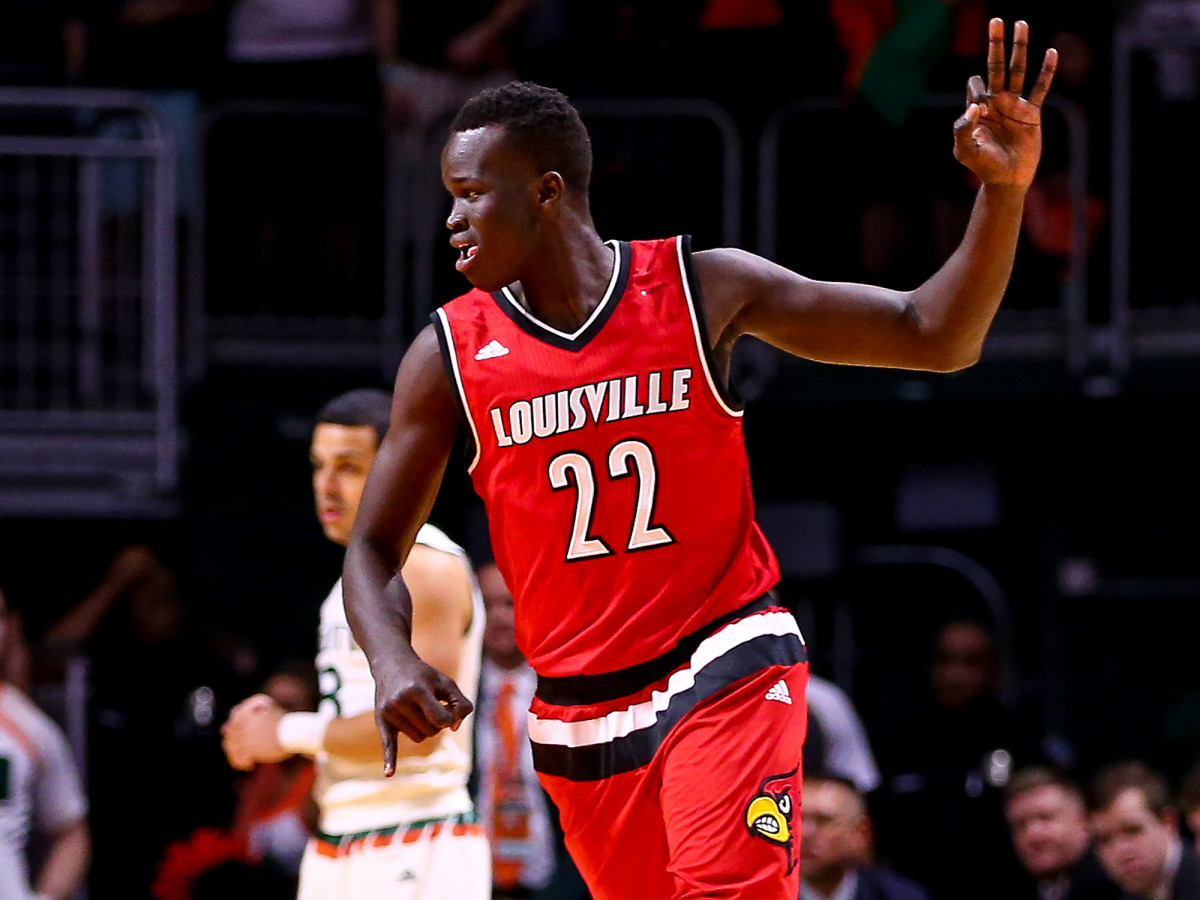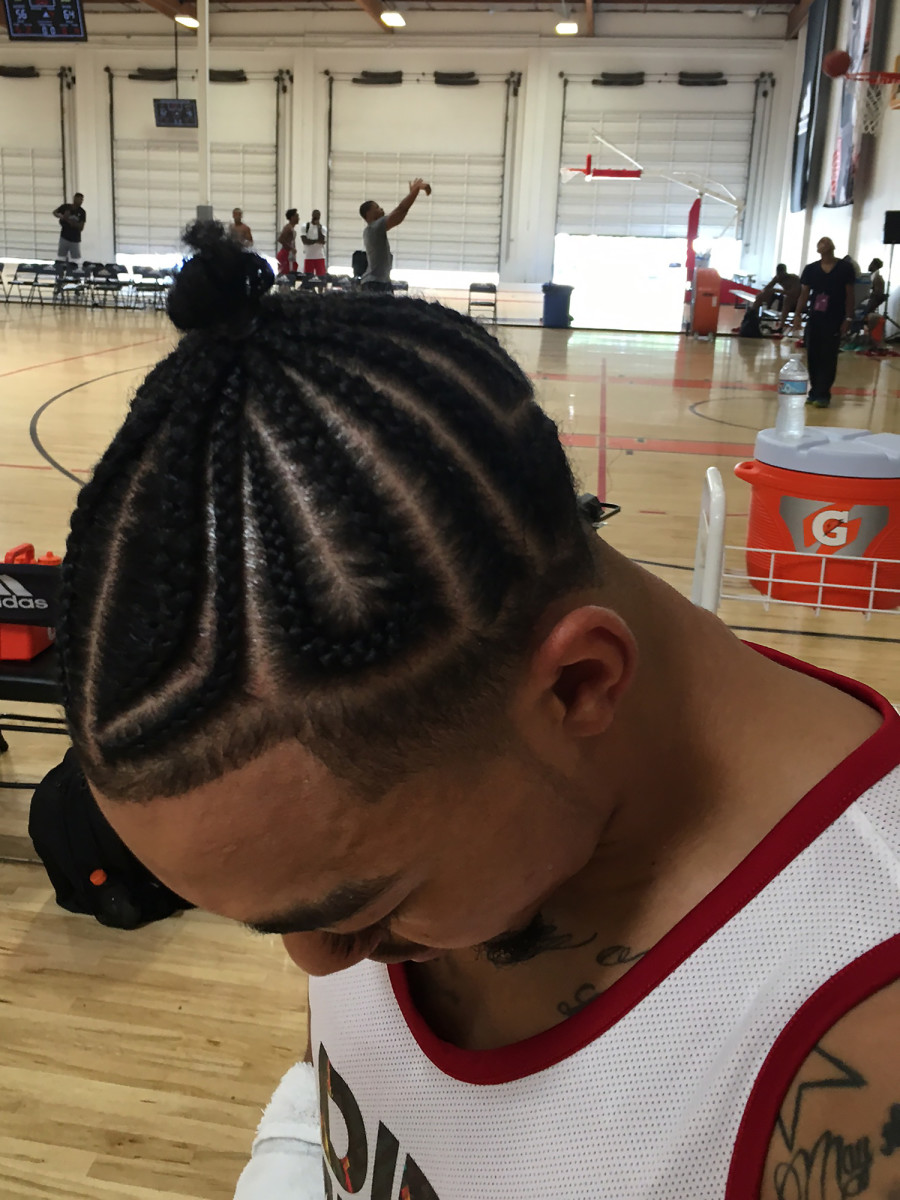Dennis Smith Jr.’s comeback & other adidas Nations observations

GARDEN GROVE, Calif. — adidas Nations is an annual camp that brings together approximately 100 of the world’s top high-school players and 35 of the U.S.’s top collegians at the Next Level Sports Complex, a steamy, warehouse-sized facility a few miles east of Long Beach. Just like at the Nike Skills Academy earlier in the week, I went to adidas Nations from July 29–31 to check in on the college prospects, who were split into four teams:
This is what I learned after scouting three days of games, all of which were refereed and statistically tracked:
• We witnessed the unveiling of a rehabilitated contender for the No. 1 pick in the 2017 NBA draft.
A camp like adidas Nations is inevitably going to mean different things to different players. For someone such as North Carolina junior Justin Jackson, who played in perhaps the greatest national championship game of all time four months ago, and will be gunning for a title again next April, it was a nice summer interlude in which to audition for NBA scouts after pulling out of the draft. Ditto for Kansas guards Devonte’ Graham and Frank Mason, who have been playing in front of packed Big 12 arenas for multiple seasons; being at the camp mattered from a scouting perspective, but I doubt it will go down as a defining moment of their college years.
For 6' 2" point guard Dennis Smith Jr., though, adidas Nations was an event—a physical and mental test the 18-year-old from Fayetteville, N.C., felt was essential before he embarks on what could be a one-and-done freshman season at NC State. “I came here,” Smith said, “to show that I’m not holding back from anything.”
On Aug. 2, 2015, Smith—who was then rated as the top floor general in the 2016 recruiting class—was playing in an adidas Nations’ high school game in the same Garden Grove gym. Smith was handling the ball on a two-on-one fastbreak, in which he drove past fellow prospect Gary Trent Jr., and planted on two feet to make a play. Smith’s left knee buckled, and rather than exploding toward the rim, he crumpled to the ground.
Smith initially tried to insist his knee was hyperextended; the camp’s final games were being broadcast on cable the following day, and he wanted to play. But he’d heard the knee pop, and he knew his injury was severe. Later that evening, in a nearby hospital, with his Raleigh-based trainer, Shawn Farmer, and few close friends at his side, Smith got the news from a doctor: His left ACL and meniscus were torn, and he’d likely have to miss his senior season of high school. For an NBA-prospect point guard whose success is based on his quick-burst ability to penetrate into the lane, this was career-threatening news. Smith cried in the hospital bed.
• Breaking down the top college players at the Nike Skills Academy
That September, when NC State’s Mark Gottfried made the grandest recruiting-visit arrival of any college coach pursuing Smith—by landing on the grounds of his Fayetteville high school in a helicopter—Smith greeted him while standing with the assistance of a crutch under his left arm. Smith committed to the Wolfpack in November and, to further his rehabilitation, graduated high school early and enrolled at NC State in January. He roomed with Cat Barber, the team’s star point guard, was eventually cleared to play in April, and convinced everyone that going back to adidas Nations was a good idea—as opposed to something that should be avoided altogether out of caution. “I told [Smith], ‘It’s like you’re returning to the scene of the crime,’” Farmer said. “But he said, ‘[The injury] isn’t even on my mind.’”
At the camp, Farmer, who’d been working with Smith for the past three months, was certain of what would happen once Smith made his public re-emergence. “He’s gonna show people that he’s back,” Farmer said, “and that he’s the best player in next year’s draft.” When Smith suited up on the morning of July 29, his first assignment was, in his words, “ironic,” but to observers, downright eerie: a transition drill on the exact same court where he’d torn the ACL on a fastbreak last August. Smith’s method of getting over it was simple: “My first chance to dunk, I went up to jump as high as I possibly could,” he said. There was no buckle. There was lift-off. He soared, he dunked, and he landed; he was his old self again.
That night, appearing in his first refereed game since August 2015, with NBA scouts filling nearly every available seat around the court at Next Level, Smith started at point guard for “Team Wizards,” which included NC State teammates Malik Abu and Maverick Rowan, as well as UNC’s Jackson and Duke’s Chase Jeter. In the first five minutes, Smith had two highlight-reel buckets—an explosive drive past Weber State’s Jeremy Senglin in the halfcourt, and an effortless change-of-pace, crossover move in transition that resulted in another score—and two steals.
Kansas’s Frank Mason, a senior with zero interest in letting himself get punked by a teenager, soon came off the bench for the opposing squad, and smothered Smith’s first drive attempt against him, knocking the ball loose. A few possessions later, Mason drew a charge on Smith in transition. It was a brief reality check—“I wanted him to feel me, to let him know that I was there,” Mason said—but it didn’t take long for Smith to acclimate. By game’s end he had fleeced both Mason and Graham for steals that were directly converted into transition buckets, and Smith finished with 17 points on 8-of-15 shooting, while Mason and Graham combined for 12 points on 4-of-11 shooting. Smith added four assists, four rebounds and six steals in 30 minutes. Aside from the fact that his team lost, 73–71, Smith’s re-unveiling was a resounding success.
While most scouts consider Washington guard Markelle Fultz, Duke forward Harry Giles and Kansas wing Josh Jackson the frontrunners for the No. 1 pick in 2017, there was real buzz in the gym about Smith following Friday’s game. As one scout put it, “No one ever makes or breaks their draft stock here, but Smith just put himself back in the conversation [for the top pick].”
Smith showed flashes of freshman-at-Wake Forest-era Chris Paul—the quick hands and disruptive defensive mentality, the elite ballhandling and drive-and-dish skills, a jumper that’s not broken but still needs work—and did enough that his circle of advisors decided to shut him down for both games the following day as a precautionary measure (allowing him to return to the court on Sunday). “Coach Gottfried,” Smith said, explaining his rest day, “told me to take it easy.”

• Louisville could be Breakout Sophomore U in 2016–17. Combo guard Donovan Mitchell was one of the better all-around backcourt players at adidas Nations. He was a committed defender who stayed in front of everyone he guarded, and has enough offensive skill—between his improved long-range shooting and powerful rim attacks—to suggest he can be an efficient double-digit scorer as a starter. The biggest revelation at the camp, however, was 6' 7" wing Deng Adel, whom Mitchell calls “the most overlooked player in the country.”
Adel, a former top-100 recruit out of Australia who had an injury-shortened, turnover-plagued freshman year, looks like he could be a valuable sophomore starter. His length makes him an impact defender, but his isolation offense is what stood out at the camp. Adel took advantage of mismatches against smaller defenders to hit fadeaway jumpers in the mid-post and drove to the rim against bigger forwards. Adel was phenomenal in his final camp game on Sunday, scoring 18 points (on 7-of-12 shooting), grabbing five rebounds and committing just one turnover in 24 minutes. He shot a camp-high 57.5% from the field and turned the ball over 2.4 times per 40 minutes, an improvement over his problematic, 3.9-per-40 rate as a freshman.
“There’s nothing Deng can’t do,” Mitchell said. “He’s physically and athletically a freak, he’s gifted, he works hard, he can score at all three levels, he’s a great defender. He’s going to be a real surprise this year, but it won’t be a surprise to everybody around Louisville.”
• Your all-adidas Nations team, according to Player Efficiency Rating:

According to DraftExpress’s cumulative stats, Deng had the second-highest PER—behind only Nevada sophomore Cam Oliver, who pulled his name out of the draft this offseason and was the camp's top breakout performer. I admit to completely sleeping on the 6' 8" Oliver as a freshman, he looks like he could be one of the Mountain West’s best frontcourt players in 2016–17. He excelled against major-conference bigs, finishing around the rim, hitting threes, rebounding and rim-protecting, and has a chance to be drafted next summer if he stays on this trajectory.
ACC Summer Reset: Can anyone challenge Duke?
• adidas Nations doubled as the Chase (Jeter) Freedom party. Jeter arrived at Duke last season as the No. 14 prospect in the Recruiting Services Consensus Index, but struggled to become a significant part of the Blue Devils’ rotation, averaging just 7.9 minutes per game. During five games in Garden Grove, Jeter scored 57 points—only four fewer than he scored all season as a Duke freshman. He averaged 11.4 points (on 55.6% shooting) and 6.8 boards; he scored on rim-rolls out of ballscreens, back-to-the-basket post moves and putbacks; and he provided some rim protection as a center on a team that generally played small lineups around him.
Jeter’s mother, Kim, was in the stands, happy to see her son looking rejuvenated, especially on Saturday evening, when he went for 21-and-6 in just 21 minutes. “Chase really, really wanted this,” Kim said—meaning that he really wanted to make an impact here, in front of NBA scouts, after a dormant freshman year. She took Snapchat videos of what had been a rare sight at Duke: Jeter getting fed in the post (and delivering) as a primary offensive option. Here he is hitting a righty hook:
The tough part for Jeter is that regardless of how well he played in California, Duke’s frontcourt rotation is going to be even more difficult to crack in ‘16–17. He’ll be battling for minutes with two potential one-and-done NBA draft lottery picks—No. 1 power-forward recruit Harry Giles and No. 1 center recruit Marques Bolden—and a super-productive fifth-year senior, Amile Jefferson. I asked Jeter what he thinks it will take for him to get on the floor as a sophomore, and he said, “I’ve just gotta bring a different type of energy [than I did as a freshman], and do all the things that I’m good at, in terms of talking, setting screens, rebounding, running the floor, and finishing when I get those dump-offs and when I get it in the post.”
• Clemson’sJaronBlossomgamewas the lone player to double up on the Nike Skills Academy and adidas Nations, which meant he played in 12 sessions of either drills or games over a seven-day span. The 6' 7" wing was one of the best players at both camps, putting himself in the first-round conversation for the 2017 draft. Blossomgame put his name in the draft this season, received serious interest as a second-round (and potentially even first-round) pick, and deliberated right up until the deadline. His Tweets (and emoji usage) conveyed that it was not an easy call ...
This is starting to get tough 🤔😒
— Jaron Blossomgame (@JaronBgame) May 16, 2016
... but he decided to pull out and return to Clemson. He said that if he had to emojify his stay in California—in which he showed he could defend the 1-4 spots in switches and have a future as an NBA role player—it would be “the thumbs up, because it’s been a pretty good week.” Blossomgame is about to have a good this week, too: On Aug. 5, he graduates with a degree in sociology.
• The camp’s boldest fashion statement was made by Monmouth’s Justin Robinson. He showed up with what he tried to describe as “just a nice, little braid ‘do,” but really, it was something that might wrest attention back from his school’s famous bench mob:

The upward-flowing, intricately stitched rows are nice, but the obvious highlight is the bun, which in that position looks like a budding, samurai top knot. The 5' 8" Robinson is leaning toward keeping it for his senior year at Monmouth, in which he should be one of the nation’s mid-major stars. Robinson didn’t get to show it much at adidas Nations, where he took on more of a distributor role, but he might be the most efficient, entertaining, sub-6-foot scorer in all of college basketball.
Recruiting Notebook: Tommy Amaker luring elite prospects to Harvard
• Thanks to the Thunder’s Steven Adams, who was at the camp monitoring the New Zealand high-school squad, for posing for this prop-aided portrait. It’s a true work of art:
• I’ll leave you with a few Texas A&M updates, one promising, one a work in progress, one merely amusing. First, although 6' 8" forward D.J. Hogg shot 33.1% from deep as a freshman, he looked like he could emerge as one of the country’s best, oversized shooters next season. Hogg was the camp’s most impressive pick-and-pop sniper, shooting 9-of-17 (52.9%) from deep, and he has the picture-perfect, repeatable form to be a 40%-plus guy for the Aggies. His game seems Kyle Wiltjer-esque in that he has elite offensive potential but needs to make progress with rebounding and defense.
Admon Gilder, meanwhile, is trying to be one of the answers to Texas A&M’s point guard question. Nearly all of the Aggies’ point guard possessions last season were handled by seniors Alex Caruso or Anthony Collins, and they have no clear heir apparent at the position. Graduate transfer JC Hampton could be an answer, but he started at the two for Lipscomb last season and is more of a combo guard. Four-star recruit J.J. Caldwell is a pass-first point guard, but he could have eligibility issues after spending the end of his high-school career as a home-schooler in Houston. He was not enrolled in summer school and is still working on getting cleared, according to his (possible) teammates.
Gilder made an impact in an off-ball role as a freshman reserve in ‘15–16, but said that A&M’s coaches want him in the mix at the point this season. He experimented as his team’s backup floor general at adidas Nations, and was conservative, initiating offensive sets but not doing much playmaking. Gilder finished the camp with three assists against six turnovers in five games, and still seems far more comfortable as a two, where he’s projected to be a valuable starter in ‘16–17.
• Gilder was one of the heroes of the craziest game in this past NCAA tournament, Texas A&M’s 12-points-in-34-seconds comeback against Northern Iowa. One postscript to that was that his parents left the arena with one minute left in the game, assuming it was a lost cause. The game was in Oklahoma City; the Gilders needed to make the four-hour drive back to Dallas, where they had to work the following morning. (OKC-stationed writers did a number of posts about the Gilders in the immediate aftermath, including this one from SI’s Pete Thamel, if you want the whole story.)
A postscript to that postscript: This summer, Gilder’s parents told him he had to attend a family event and that he’d be expected to stay the entire time. They were going fishing and swimming; Admon, who’s not a fan of sun-exposed activities, wanted to stay inside. His solution? Playing the Northern Iowa Card. “You didn’t stay for the whole NCAA tournament game,” he told his parents, “so I don’t have to stay for all of this.” They gave in, and he was allowed to go home early.
